|
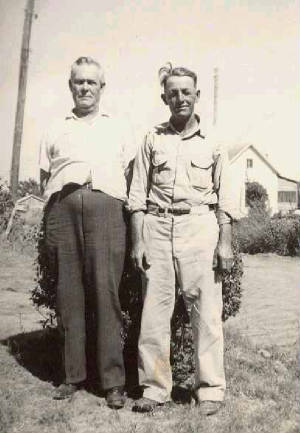
By now Mama really wanted us to move away from Granny's house because they just couldn't get
along at all, but the depression had put a real crunch on their finances. The bales of cotton were only bringing about ten
cents a pound, about fifty dollars a bale. Before the depression it was bringing ten times that much. Daddy still worked at
the gin in the fall after the farm work was done and made about a dollar a day. Still my parents were able to save a little,
hoping to get enough to find us a place to move.
After Mama had a big fuss with Granny she came to Daddy crying and said, "I've got to get out
of this place; I'll be willing to live anywhere." Daddy said, "We haven't saved enough money to buy a place of our own, but
we could rent The Old Place (Granny's farm) from my mother and build a log house on it. That's the best we can do." Well,
to say the least, Mama was overjoyed and they began making preparations to build it. They didn't want to spend any money on
rent so they made a deal with Granny to give her one fourth of the money from the crops, and she agreed. (I imagine Granny
was ready for Mama to get out of her house).
Kenny Shelton 'Pa' Stone and Wes Tom Johnson (my daddy). They worked together and built two
log houses, one for each of them.
They decided to build the log house just in front of the old house, now fallen down.
Everett Cain and Naomi had lived in that house and their first child, James Wesley was born there. That way they could remove
the debris from the old house later. The farm was only fifty acres; twenty acres of cotton land, fifteen acres of cow pasture
land, nine acres of hay meadow and the rest was woods. The woods and part of the pasture were bottom land, part of the North
Sulphur River bottom land that flooded when the river overflowed. Granny told them they could cut all the logs they wanted
from the woods to build the house and for firewood.
Daddy and Mama counted their money and priced building materials for the house. They decided
there was enough money to buy two doors, two windows, nails, lumber for the rafters, ceiling and floor. The rest they would
have to cut from logs. Even the shingles for the roof had to be cut from logs by sawing them into short blocks and slicing
them with an ax.
Daddy told Mama he would need help cutting the logs, for they had to be cut by hand. He had
a long saw for cutting down trees called a crosscut saw. It took two men to use it, one man on each end of the saw. Mama said
she would write her father, Kenny Shelton Stone who still lived in Craddock, to come and help. Both he and Nellie (I called
them Big Mama and Pa) were excited about us getting a new log house, and
they came to see us. Mama convinced them to move here and build a log house for them also. Granny told them it would be alright
to build them both on her land.
Kenny Shelton 'Pa' and Nellie 'Big Mama' Stone in front of their log house. If this picture
had been in color you could see Big Mama's beautiful flowers along the dirt walk.
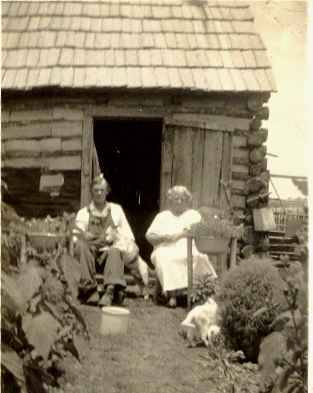
Soon they started cutting the logs and dragging them from the woods with mules. It was hard
work for them and Pa was close to sixty years old at this time. Finally, the two houses were finished; both of them only had
one room. Our house had two windows in the front, a front and back door, each with screen doors. The ceiling and floor was
made from new lumber. Pa and Big Mama did not have much money and very little was spent on their house. It had a hard-packed
dirt floor, but Big Mama kept it swept with a broom. There was only one door and one window. The window did not have any screen
or glass in it, just shutters made from old boards. When the shutters were closed it was dark, even in the daytime, so they
lit a coal-oil lamp. The door was also made from old boards, probably from the old fallen down house. Even the rafters were
made of poles.
I was about two years old when we moved into our new house; that was in 1935, the year Johnny drowned. I can't
remember living at Granny's, but I remember sitting on the front step of our log house and Mama taking my picture, I was probably
about three years old. Mama was so happy when we moved in, she made curtains for the two windows and did many other things
to make the house pretty. They were as proud of it as if it had cost a million dollars. However, the depression was not over
yet, but Mama and Daddy were hard-working, young and energetic. They were determined to make their new life a success, as
they looked toward the hard times ahead and faced an uncertain future.
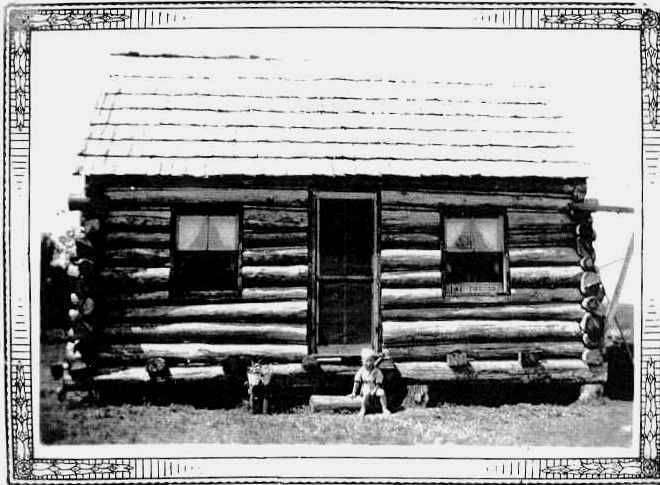
Earl Johnson (me) sitting on the step of our log house.
Picture taken about 1936.
The years that followed brought many difficult hardships on my parents, and looking back and
remembering the old days and the stressful tasks they endured, I wonder how they coped with them. The house didn't have any
water and Daddy had to haul water from a spring about two miles away on our neighbor's land. They were good neighbors and
said we could have all the water we wanted, for the spring never went dry. Daddy would load wooden barrels in the wagon, pulled
by mules or horses. I can remember going with him for the water; I must have been about three or four years old. Daddy drew
the water from the spring with a bucket tied to a long rope and filled the barrels.
After a time he dug a cistern close to our house. He put rain gutters on the house to catch
the rain water and into the cistern. When it didn't rain for awhile the cistern would go dry and again we had to haul water.
I remember Mama drawing water from the cistern with a rope and bucket for
drinking, cooking, washing dishes, clothes and for bathing. We took a bath in the washtub, the same tub she used to wash our
clothes. She did the laundry by putting a rub board in the tub and used a big bar of soap, usually homemade lye soap. For
the really dirty clothes, like Daddy's work clothes, she used a large, black pot called a wash pot. She filled the pot with
water and built a fire under and around it. When the water boiled she took a long stick, she called a punching stick, and
punch the clothes around. This boiling action was similar to the agitation of a washing machine. Mama made a garden every
year and grew most of our food. Big Mama and Pa helped and they grew enough for us and them. Daddy and Pa also had an orchard
and raised peaches, plumbs, figs and other fruit.
Wes Tom and Nell Johnson, and their first child Earl (me). The picture was taken about
the time we moved into our log house.
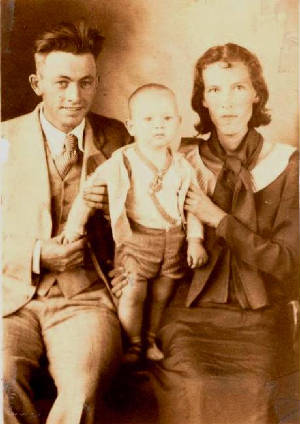
They would raised extra food for canning. Mama and Big Mama would put the food in fruit jars
and put them in a pressure cooker. Then we had food during the winter. This was our only way of preserving food for we had
no refrigerator or freezer. They wouldn't have done us much good anyway, for we had no electricity. Just about all of our
food came from the farm; Daddy always raised about a half acre of sorghum cane for making sorghum molasses. He and Pa would
cut the stalks of cane and load them on the wagon and take them to a syrup mill. They didn't have enough money to pay the
man for making the syrup so they paid him with a percentage of what was made. This method of payment was used for other things
also, such as for grinding corn into meal. Daddy would take a wagon load of corn to a grinding mill in Cooper to be ground
into corn meal, and pay the man with a percentage of the meal. He also had beehives that produced enough honey for us and
Pa and Big Mama. We always had hogs for meat and sometimes a calf. Daddy and Pa would kill and butcher them. We always looked
forward to this day for the fresh meat. It always had to be on a very cold day so the meat would not spoil. They boiled the hog fat in a wash pot to make lard. Mama used it for all her cooking. After they
cut up the meat they persevered it by rubbing it with a salt-like substance called sugar cure. The sugar cured meat would
last throughout the winter but had to be eaten before hot weather. We also had chickens and lots of eggs, even some to sell.
Earl and Kerry Johnson. These were their only children who lived in the log house.
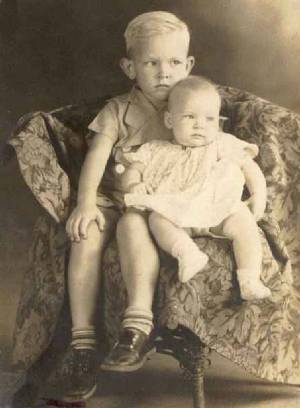
We had a few cows; we always had plenty of milk and butter and Daddy sold some of the milk.
Pat Ayles, Daddy's uncle, had a milk route. Pat and Winnie (Granny's sister) lived about a mile south of us; we could look
across the field and see their house. Pat would come by in an old flat bed truck and pick up the cans of milk, five and ten
gallon cans. Sometimes his daughter Virginia, would come with him to help and sometimes she ran the route by herself. The
money from the sale of the milk sure helped out.
Later many farmers bought a cream separator; it would separate the cream from the milk. Once
a week, usually on Saturday, we would go to Cooper and take the cans of cream to a creamery and sell it. Later we sometimes
shipped the cans by train from Paris to the Sooner Creamery in Oklahoma City.
When I was five years old Mama told me that they were going to get me a little sister. I asked
where they were getting her from. Since I was too young to know about the birds and the bees she told me they had ordered
her from the Sears Roebuck mail order catalog. She knew I understood about the catalog for we ordered a lot of things from
it. I opened the catalog to the little girls clothing section and saw a pretty little girl and said to Mama, "I hope its this
one." She looked and saw the girl was modeling Kerrybrook dresses, so she decided to name her either Kerry or Brook. When
she was born she named her Kerry.
Having another child increased my parents hardships even more, for the depression was still
not over. Money was still hard to come by so Daddy continued to work at the gin in the fall after his crops were in. He bought an old Model T Ford but most of the time it wouldn't run so he walked to and from the gin. The gin was about
a mile from our house but we could hear the steam whistle when they blew it. Daddy had a signal to Mama with the whistle.
This told her he was on his way and she would start cooking supper.
Wes Tom, looking tired after a hard day of mowing hay.
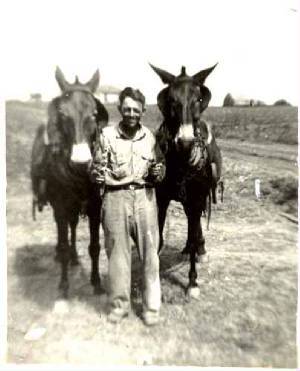
By now several farmers in our area had tractors, but Daddy still did all of his farming with horses and mules;
the plowing, planting and hay mowing. When the hay was ready to bale it took six men and several horses to bale it. Daddy
didn't have enough money to hire them so some of the neighbors helped. They all helped each other for no one had very much
money. First, Daddy would mow the hay with a horse drawn sickle mower.
After it was dry the men would come. Someone brought a stationary hay baler and set it up in
the middle of the meadow. It was powered by a horse or mule. There was a gearbox placed about twenty feet from the baler with
a long shaft going to the baler. It was close to the ground so the horse could step over it. The horse was hitched to one
end of a long pole and the other end was connected to the gearbox. One of the kids would ride the horse as he went around
in a circle, stepping over the shaft as he went. As the shaft turned a plunger would go up and down pressing the hay into
the bale. When the plunger went up a man would put a pitchfork full of hay in the bailer. Blocks were used to separate the
bales. As a bale went out the man would drop another block in the baler. Two men, one on each side of the press, pushed wires
called baling wire, through groves in the blocks and the man on the other side would tie it.
Another man drove a horse drawn hay rake called a sulky rake. This put the hay in long rows. Another man
drove a horse drawn rake called a buck rake, it was made of long fork-like poles that slid across the ground. It went down
the rows pushing the hay into a large pile. Then the man would turn aside and take the pile of hay to the baler. He would
make the horses back up, pulling the hay forks out from under it. Other men stacked the bales of hay on a wagon and took them
to the barn.
I remember a funny story my mother once told me about Vivian. She was supposed to be watching
the hay going into the press and tell the man when another block was needed. She had a True Story Magazine and was reading
it while she waited between blocks, which took about five minutes. After a time she became so consumed with the story that
she forgot to tell the man and too much hay went into the bale and it burst.
The man bawled her out a little then continued. In a little while the same thing happened again.
The man grabbed the magazine out of Vivian's hand and through it in the press and it became part of the bale. She got in the
man's face and told him what she thought of him. Then she waited for the bale to come out, ripped the wires off it and scattered
the hay until she found her magazine.
Big Mama, standing in the yard at her log house.
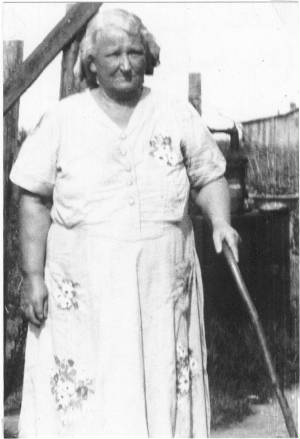
Big Mama and Pa's log house was just down the road from our house and I remember spending a lot of time there.
Like most grandparents, they spoiled me a little. Pa loved to go fishing and sometimes he let me go with him. He kept his
fishing poles laying up on the exposed rafters. I soon learned that if I wanted to go fishing all I had to do was go out behind
the barn and dig some worms. I'd take them to him and say, "Look at these worms Pa!" He would reach up and take his fishing
poles down from the rafters, get his hat and we would we be off. There were several pools, or ponds, of water around about
so we didn't have to go very far.
Big Mama was a kind and gentle person; she was patient with me and would sit for hours reading
to me and telling me stories. Sometimes she told me about the good old days before the depression. She said that they used
to go to church and that God answered a lot of prayers for them.
Once they had a car and the headlights would not burn. In fact they had never worked since they
had the car even though Pa worked on them, so they only drove it in the daytime. Late one day they started home and it begin
to get dark before they got home. Finally it got so dark Pa was afraid to go any farther, so he stopped the car and they laid
their hands on the car and prayed. You guessed it! The lights came on. I know they had a lot of faith because I could hear
them praying in their house.
As I said earlier, the log house did not have electricity and neither did any of our neighbors,
except a few who had wind-chargers. Daddy said that he could make one if he had the right materials. One day he came home
and said that he was going to build a wind-charger to make electricity for our house. He had bought some parts from a
neighbors wrecked car; a six volt generator, battery and the radio. He ordered some wiring,
light bulb sockets, six volt light bulbs (they had six volt bulbs that fit a standard light socket. The bulbs were 100 watt
and would burn bright like those used in campers today).
He went to the woods and cut long poles and made a tower, a little taller than our house. He
mounted the generator in a spindle and fastened it on top of the tower. The generator would swivel back and forth on the spindle.
Then he whittled a propeller from a long board and fastened it to the generator. He made a tail fin for the back of the generator
that made it turn on the swivel directing the propeller always toward the wind, sort of like a windmill. He ran two wires
from the generator down to the battery and two more wires from the battery to the radio. When the wind blew the battery received
a charge and I heard a radio play for the first time. Then he installed the wiring and sockets and we had electric lights.
That was quite a big deal for me, for we always used kerosene lamps or candles.
Some of our close neighbors would come to our house to hear the radio, especially on Saturday
night to listen to the Grand Ole Opre and the prize fights. Sometimes we would listen to programs like Fibber McGee and Molly,
Amos and Andy or a ballgame.
Sometimes when the wind did not blow for awhile the battery would go dead and Daddy would ask
Pat to switch batteries and charge ours as he ran the milk route. Pat did not seem to mind but he had to start the truck with
a hand crank until the dead battery was charged.
Pa & Big Mama holding their first four grandchildren, Pa holding Buster & Earl and Big
Mama holding Wanda & Billie. The 'Big Four'.
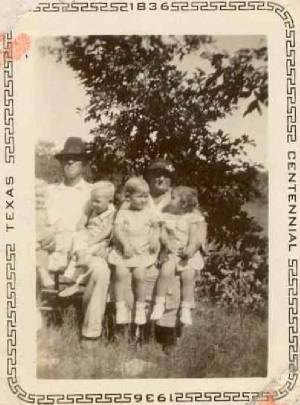
Mama had two sisters and one brother; all were married and had a child near my age. He oldest sister was named Mozelle
'Moze' (Stone) Wheat. They lived in De Queen, Arkansas and had a daughter named Wanda Jean Wheat. Her next sister was named
Eudelle 'Pud' (Stone) Mackey. She was married to Early Mackey and they had a son named Doyle Edward 'Buster' Mackey. Her brother
was named William Trent 'Bill' Stone. His wife was named Annie and they had a daughter named Billie. Once they all came to
visit us at one time, some staying at our house and some at Pa and Big Mama's house. That was the first time I had seen them;
Mama took a picture of us four cousins and they called us the ‘Big Four‘.
In 1940 I started to school at the Lake Creek School, it was about a mile down the road and
I had to walk. It wasn't so bad though unless it was cold or raining. When it rained that black-land dirt became boggy, if
you know what that mean, real sticky mud worse than clay. They had an old saying, "If you will stick with the land when it’s
dry, it will stick with you when it rains." How true! There was an old shaky footbridge that we had to cross over a creek.
It was scary walking across it when it rained for it was slick, shaky and slanted over the raging water below us. Sometimes
I walked through the deep snow which was not much fun.
The school was an elementary school up to the eighth grade, but there were only three rooms
in the small schoolhouse. Each room would have two or three grades in them. Our desks were in different sections of the room
and my room had three grades. The teacher would go from one group to another, teaching each a few minutes at a time. There
was a large playground and ball field and I really liked to play ball. The school did not have inside bathrooms, only two
large outhouses. I had never seen an inside bathroom at this time. There was a lunchroom but I always took my lunch because
Daddy couldn't afford the twelve cents a week.
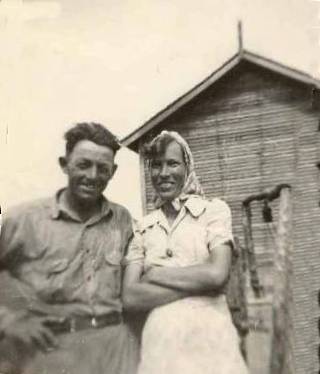
That same year my parents bought a house and fifty acres of farmland about a half mile east
of us. They bought it from Russell Edwards, a close friend, for $1,400. They also bought some horse-drawn farming equipment
from him for two hundred dollars. They financed the $1,600 at the First National Bank in Cooper and paid it off in four annual
payments.
That same year, 1940, my parent's third child was born; a son and they named him Jerry Thomas
'JJ' Johnson .
Wes Tom & Nell standing at the west end of the house they bought.
|

